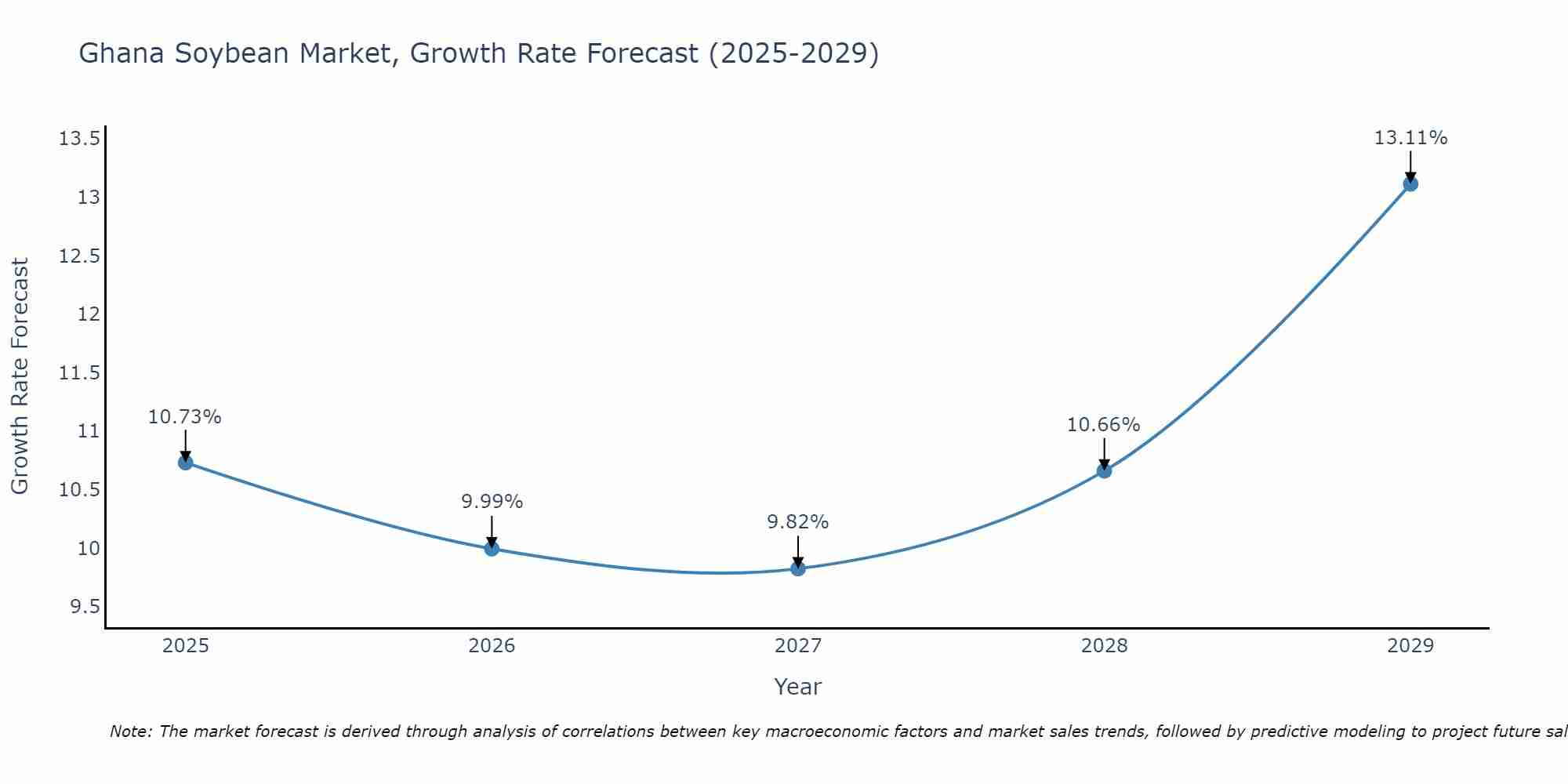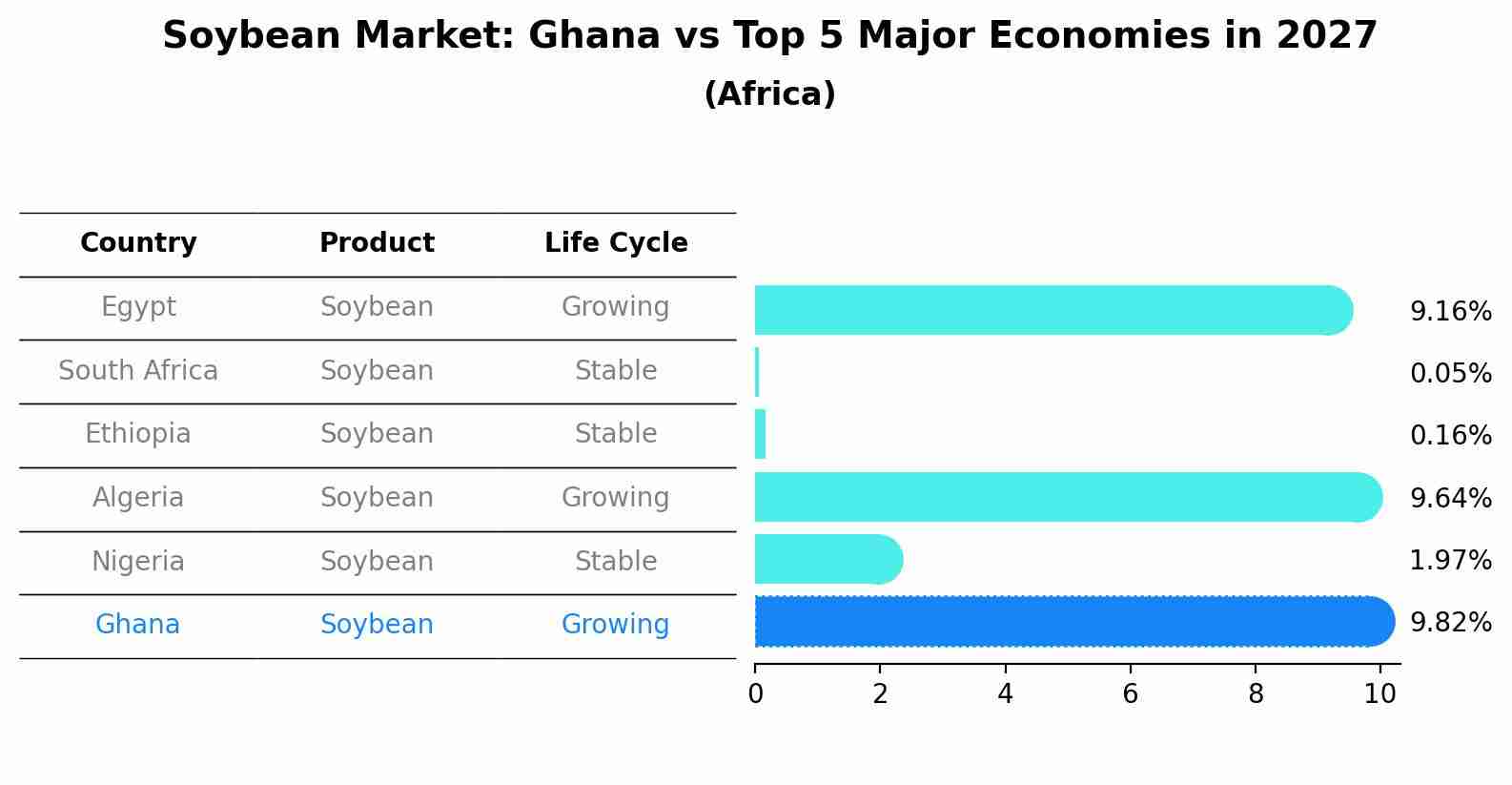Ghana Soybean Market (2025-2031) Outlook | Size, Value, Companies, Industry, Forecast, Analysis, Trends, Share, Growth & Revenue
| Product Code: ETC224696 | Publication Date: Aug 2022 | Updated Date: Aug 2025 | Product Type: Market Research Report | |
| Publisher: 6Wresearch | Author: Summon Dutta | No. of Pages: 75 | No. of Figures: 35 | No. of Tables: 20 |
Ghana Soybean Market Size Growth Rate
The Ghana Soybean Market is projected to witness mixed growth rate patterns during 2025 to 2029. The growth rate starts at 10.73% in 2025 and reaches 13.11% by 2029.

Soybean Market: Ghana vs Top 5 Major Economies in 2027 (Africa)
The Soybean market in Ghana is projected to grow at a growing growth rate of 9.82% by 2027, within the Africa region led by Egypt, along with other countries like South Africa, Ethiopia, Algeria and Nigeria, collectively shaping a dynamic and evolving market environment driven by innovation and increasing adoption of emerging technologies.

Ghana Soybean Market Overview
The Ghana soybean market is experiencing steady growth driven by increasing demand for soybean products in various industries such as food processing, animal feed production, and pharmaceuticals. The country`s favorable climate and soil conditions support soybean cultivation, with farmers increasingly adopting modern agricultural practices to improve yields. However, challenges such as limited access to credit, inadequate infrastructure, and fluctuating global prices pose obstacles to the market`s expansion. Government initiatives to promote soybean production and processing, as well as partnerships with international organizations, are helping to address these issues and boost the competitiveness of the Ghanaian soybean market. Overall, the market presents opportunities for investors and stakeholders looking to capitalize on the growing demand for soybean products in Ghana and beyond.
Ghana Soybean Market Trends
Currently, the Ghana soybean market is experiencing a growing demand due to the increasing awareness of its health benefits and versatility in various food products. Local consumption of soybean products is on the rise as more Ghanaians are incorporating soy-based foods into their diets for their high protein content and nutritional value. Additionally, the government`s efforts to promote soybean cultivation as a means to improve food security and reduce the country`s reliance on imports have led to an expansion of soybean production. However, challenges such as limited access to credit for small-scale farmers, inconsistent rainfall patterns, and inadequate storage facilities still hinder the market`s growth potential. Overall, the Ghana soybean market is poised for further development, driven by both domestic consumption and export opportunities.
Ghana Soybean Market Challenges
In the Ghana Soybean Market, some of the major challenges include inconsistent weather patterns leading to fluctuations in crop yields, limited access to quality inputs such as seeds and fertilizers, inadequate storage facilities resulting in post-harvest losses, and a lack of technical knowledge among farmers regarding best practices for soybean cultivation. Additionally, the market faces issues with unreliable market information and price volatility, hindering farmers` ability to make informed decisions. Furthermore, inadequate infrastructure and transportation networks make it difficult to efficiently transport soybeans from rural areas to urban markets, limiting market access for farmers. Addressing these challenges will require coordinated efforts from government agencies, private sector stakeholders, and development partners to improve the overall competitiveness and sustainability of the Ghana Soybean Market.
Ghana Soybean Market Investment Opportunities
In the Ghana Soybean market, there are promising investment opportunities due to the increasing demand for soybean products both domestically and globally. Investors can consider opportunities in soybean farming, processing facilities, and trading operations. With Ghana`s favorable climate for soybean cultivation and government support for agricultural development, investing in soybean farming can be lucrative. Additionally, establishing processing facilities to produce soybean oil, meal, and other derivatives to meet the growing demand can be a profitable venture. Lastly, investing in trading operations to export soybean products to international markets can also yield significant returns. Overall, the Ghana Soybean market presents diverse investment opportunities across the value chain for investors looking to capitalize on the expanding market demand.
Ghana Soybean Market Government Policy
Government policies related to the Ghana Soybean Market include the implementation of the Planting for Food and Jobs program, which aims to increase soybean production through the provision of subsidized inputs and extension services to farmers. The government also offers support for soybean farmers through the Ghana Incentive-Based Risk-Sharing Agricultural Lending (GIRSAL) program, which provides credit guarantees to encourage lending to agricultural enterprises. Additionally, there are policies in place to promote value addition and processing of soybeans locally, such as the One-District-One-Factory initiative. Overall, these policies are geared towards boosting domestic production, increasing self-sufficiency, and enhancing the competitiveness of the Ghanaian soybean market.
Ghana Soybean Market Future Outlook
The future outlook for the Ghana Soybean Market appears promising due to increasing demand driven by the growing awareness of the health benefits associated with soy products. Additionally, the government`s initiatives to promote soybean cultivation as part of efforts to enhance food security and reduce reliance on imports are expected to boost production levels. With favorable agro-climatic conditions and the potential for increased investment in modern farming practices, Ghana is well-positioned to expand its soybean production capacity. However, challenges such as limited access to financing for small-scale farmers and fluctuating global market prices may hinder market growth. Overall, the Ghana Soybean Market is projected to experience steady growth in the coming years, presenting opportunities for both domestic producers and investors.
Key Highlights of the Report:
- Ghana Soybean Market Outlook
- Market Size of Ghana Soybean Market, 2024
- Forecast of Ghana Soybean Market, 2031
- Historical Data and Forecast of Ghana Soybean Revenues & Volume for the Period 2021 - 2031
- Ghana Soybean Market Trend Evolution
- Ghana Soybean Market Drivers and Challenges
- Ghana Soybean Price Trends
- Ghana Soybean Porter's Five Forces
- Ghana Soybean Industry Life Cycle
- Historical Data and Forecast of Ghana Soybean Market Revenues & Volume By Applications for the Period 2021 - 2031
- Historical Data and Forecast of Ghana Soybean Market Revenues & Volume By Crush for the Period 2021 - 2031
- Historical Data and Forecast of Ghana Soybean Market Revenues & Volume By Feed Use for the Period 2021 - 2031
- Historical Data and Forecast of Ghana Soybean Market Revenues & Volume By Food Use for the Period 2021 - 2031
- Ghana Soybean Import Export Trade Statistics
- Market Opportunity Assessment By Applications
- Ghana Soybean Top Companies Market Share
- Ghana Soybean Competitive Benchmarking By Technical and Operational Parameters
- Ghana Soybean Company Profiles
- Ghana Soybean Key Strategic Recommendations
Frequently Asked Questions About the Market Study (FAQs):
1 Executive Summary |
2 Introduction |
2.1 Key Highlights of the Report |
2.2 Report Description |
2.3 Market Scope & Segmentation |
2.4 Research Methodology |
2.5 Assumptions |
3 Ghana Soybean Market Overview |
3.1 Ghana Country Macro Economic Indicators |
3.2 Ghana Soybean Market Revenues & Volume, 2021 & 2031F |
3.3 Ghana Soybean Market - Industry Life Cycle |
3.4 Ghana Soybean Market - Porter's Five Forces |
3.5 Ghana Soybean Market Revenues & Volume Share, By Applications, 2021 & 2031F |
4 Ghana Soybean Market Dynamics |
4.1 Impact Analysis |
4.2 Market Drivers |
4.2.1 Increasing demand for plant-based protein sources |
4.2.2 Growing awareness about the health benefits of soybeans |
4.2.3 Government support and initiatives to promote soybean production in Ghana |
4.3 Market Restraints |
4.3.1 Dependence on weather conditions for successful soybean cultivation |
4.3.2 Competition from other oilseed crops |
4.3.3 Lack of infrastructure for efficient storage and distribution of soybeans |
5 Ghana Soybean Market Trends |
6 Ghana Soybean Market, By Types |
6.1 Ghana Soybean Market, By Applications |
6.1.1 Overview and Analysis |
6.1.2 Ghana Soybean Market Revenues & Volume, By Applications, 2021 - 2031F |
6.1.3 Ghana Soybean Market Revenues & Volume, By Crush, 2021 - 2031F |
6.1.4 Ghana Soybean Market Revenues & Volume, By Feed Use, 2021 - 2031F |
6.1.5 Ghana Soybean Market Revenues & Volume, By Food Use, 2021 - 2031F |
7 Ghana Soybean Market Import-Export Trade Statistics |
7.1 Ghana Soybean Market Export to Major Countries |
7.2 Ghana Soybean Market Imports from Major Countries |
8 Ghana Soybean Market Key Performance Indicators |
8.1 Average yield per hectare of soybean cultivation |
8.2 Adoption rate of modern farming techniques in soybean production |
8.3 Percentage of agricultural land in Ghana allocated to soybean cultivation |
9 Ghana Soybean Market - Opportunity Assessment |
9.1 Ghana Soybean Market Opportunity Assessment, By Applications, 2021 & 2031F |
10 Ghana Soybean Market - Competitive Landscape |
10.1 Ghana Soybean Market Revenue Share, By Companies, 2024 |
10.2 Ghana Soybean Market Competitive Benchmarking, By Operating and Technical Parameters |
11 Company Profiles |
12 Recommendations |
13 Disclaimer |
- Single User License$ 1,995
- Department License$ 2,400
- Site License$ 3,120
- Global License$ 3,795
Search
Thought Leadership and Analyst Meet
Our Clients
Related Reports
- Afghanistan Apparel Market (2026-2032) | Growth, Outlook, Industry, Segmentation, Forecast, Size, Companies, Trends, Value, Share, Analysis & Revenue
- Canada Oil and Gas Market (2026-2032) | Share, Segmentation, Value, Industry, Trends, Forecast, Analysis, Size & Revenue, Growth, Competitive Landscape, Outlook, Companies
- Germany Breakfast Food Market (2026-2032) | Industry, Share, Growth, Size, Companies, Value, Analysis, Revenue, Trends, Forecast & Outlook
- Australia Briquette Market (2025-2031) | Growth, Size, Revenue, Forecast, Analysis, Trends, Value, Share, Industry & Companies
- Vietnam System Integrator Market (2025-2031) | Size, Companies, Analysis, Industry, Value, Forecast, Growth, Trends, Revenue & Share
- ASEAN and Thailand Brain Health Supplements Market (2025-2031) | Strategy, Consumer Insights, Analysis, Investment Trends, Opportunities, Growth, Size, Share, Industry, Revenue, Segments, Value, Segmentation, Supply, Forecast, Restraints, Outlook, Competition, Drivers, Trends, Demand, Pricing Analysis, Competitive, Strategic Insights, Companies, Challenges
- ASEAN Bearings Market (2025-2031) | Strategy, Consumer Insights, Analysis, Investment Trends, Opportunities, Growth, Size, Share, Industry, Revenue, Segments, Value, Segmentation, Supply, Forecast, Restraints, Outlook, Competition, Drivers, Trends, Demand, Pricing Analysis, Competitive, Strategic Insights, Companies, Challenges
- Europe Flooring Market (2025-2031) | Outlook, Share, Industry, Trends, Forecast, Companies, Revenue, Size, Analysis, Growth & Value
- Saudi Arabia Manlift Market (2025-2031) | Outlook, Size, Growth, Trends, Companies, Industry, Revenue, Value, Share, Forecast & Analysis
- Uganda Excavator, Crane, and Wheel Loaders Market (2025-2031) | Strategy, Consumer Insights, Analysis, Investment Trends, Opportunities, Growth, Size, Share, Industry, Revenue, Segments, Value, Segmentation, Supply, Forecast, Restraints, Outlook, Competition, Drivers, Trends, Demand, Pricing Analysis, Competitive, Strategic Insights, Companies, Challenges
Industry Events and Analyst Meet
Whitepaper
- Middle East & Africa Commercial Security Market Click here to view more.
- Middle East & Africa Fire Safety Systems & Equipment Market Click here to view more.
- GCC Drone Market Click here to view more.
- Middle East Lighting Fixture Market Click here to view more.
- GCC Physical & Perimeter Security Market Click here to view more.
6WResearch In News
- Doha a strategic location for EV manufacturing hub: IPA Qatar
- Demand for luxury TVs surging in the GCC, says Samsung
- Empowering Growth: The Thriving Journey of Bangladesh’s Cable Industry
- Demand for luxury TVs surging in the GCC, says Samsung
- Video call with a traditional healer? Once unthinkable, it’s now common in South Africa
- Intelligent Buildings To Smooth GCC’s Path To Net Zero


















